The AMD Ryzen 7 5700G, Ryzen 5 5600G, and Ryzen 3 5300G Review
by Dr. Ian Cutress on August 4, 2021 1:45 PM ESTMicrobenchmarks
Core-to-Core Latency
As the core count of modern CPUs is growing, we are reaching a time when the time to access each core from a different core is no longer a constant. Even before the advent of heterogeneous SoC designs, processors built on large rings or meshes can have different latencies to access the nearest core compared to the furthest core. This rings true, especially in multi-socket server environments.
But modern CPUs, even desktop and consumer CPUs, can have variable access latency to get to another core. For example, in the first-generation Threadripper CPUs, we had four chips on the package, each with 8 threads, and each with a different core-to-core latency depending on if it was on-die or off-die. This gets more complex with products like Lakefield, which has two different communication buses depending on which core is talking to which.
If you are a regular reader of AnandTech’s CPU reviews, you will recognize our Core-to-Core latency test. It’s a great way to show exactly how groups of cores are laid out on the silicon. This is a custom in-house test built by Andrei, and we know there are competing tests out there, but we feel ours is the most accurate to how quick an access between two cores can happen.
The Ryzen 7 5700G has the quickest thread-to-thread latency, however does offer a single slowest core-to-core latency. But compared to the 4000G series, having a single unified L3 cache reduces to core-to-core latency a good amount. The Ryzen 5 5300G has the slowest intracore latency, but the fastest average core-to-core.
Per-Core Power
One other angle to examine is how much power each core is drawing with respect to the rest of the chip. In this test, we run POV-Ray with a specific thread mask for a minute, and take a power reading 30 seconds into the test. We output the core power values from all cores, and compare them to the reported total package power.
The peak per-core power is shown as 15.2 W when one core is loaded on the Ryzen 7 5700G, and that comes down to ~8.8W when all cores are loaded. Interestingly this processor uses more power when six cores are loaded.
The Ryzen 5 5300G starts at 11.5 W for a single core, but then moves up to 12.3 W when three cores are loaded. It comes back down to 11.5 W when all four cores are loaded, but this ensures a consistent frequency (the 5300G has a 4.2 GHz Base and 4.4 GHz Turbo, explaining the small variation in loading).
Frequency Ramping
Both AMD and Intel over the past few years have introduced features to their processors that speed up the time from when a CPU moves from idle into a high-powered state. The effect of this means that users can get peak performance quicker, but the biggest knock-on effect for this is with battery life in mobile devices, especially if a system can turbo up quick and turbo down quick, ensuring that it stays in the lowest and most efficient power state for as long as possible.
Intel’s technology is called SpeedShift, although SpeedShift was not enabled until Skylake.
One of the issues though with this technology is that sometimes the adjustments in frequency can be so fast, the software cannot detect them. If the frequency is changing on the order of microseconds, but your software is only probing frequency in milliseconds (or seconds), then quick changes will be missed. Not only that, as an observer probing the frequency, you could be affecting the actual turbo performance. When the CPU is changing frequency, it essentially has to pause all compute while it aligns the frequency rate of the whole core.
We wrote an extensive review analysis piece on this, called ‘Reaching for Turbo: Aligning Perception with AMD’s Frequency Metrics’, due to an issue where users were not observing the peak turbo speeds for AMD’s processors.
We got around the issue by making the frequency probing the workload causing the turbo. The software is able to detect frequency adjustments on a microsecond scale, so we can see how well a system can get to those boost frequencies. Our Frequency Ramp tool has already been in use in a number of reviews.
In our test, the Ryzen 5 5600G jumps from 2700 to the turbo frequency in around a millisecond.


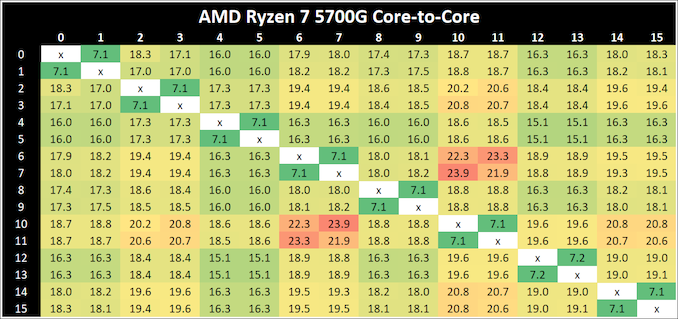
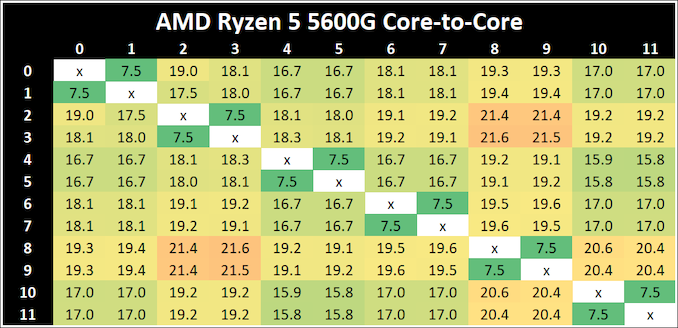
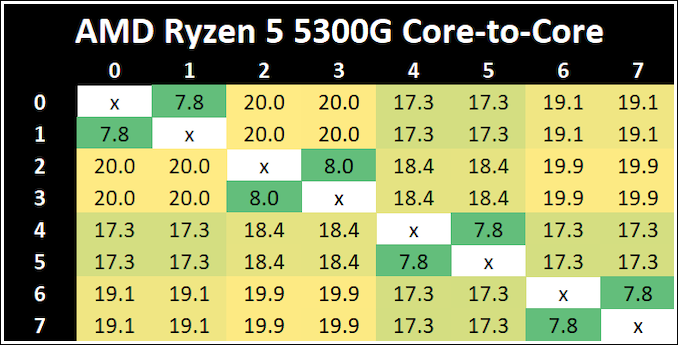
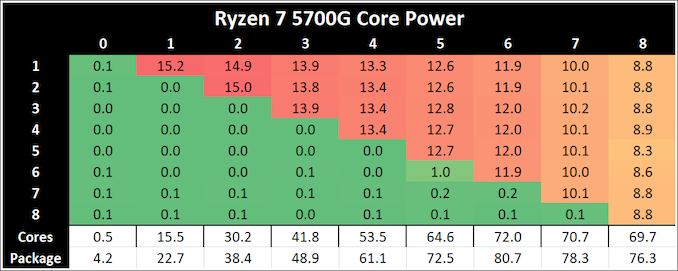

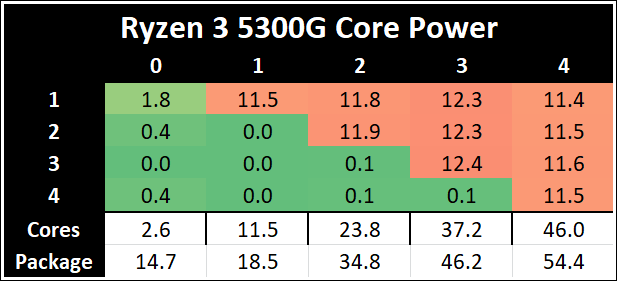
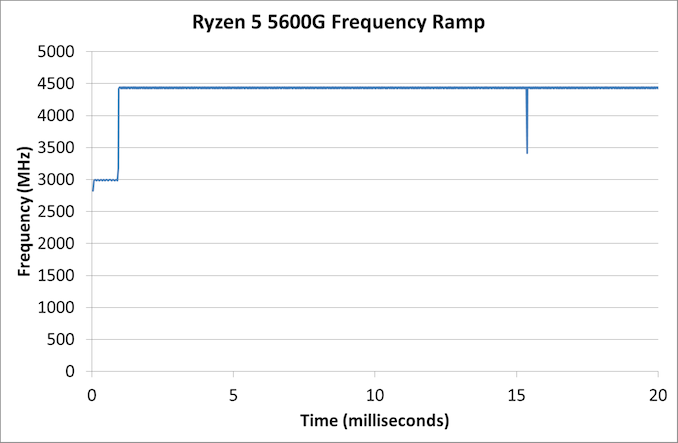








135 Comments
View All Comments
DanNeely - Wednesday, August 4, 2021 - link
"What makes these ones different this time around is that Intel is cutting the Ryzen 3 from retail,"AND here, not Intel.
dwillmore - Wednesday, August 4, 2021 - link
And they use Zen3 *processors*, not graphics.Rudde - Wednesday, August 4, 2021 - link
“As it stands, these two new processors at retail fill out Intel’s retail offerings, at least down to $259.”Again, it is AMD's retail offerings.
at_clucks - Wednesday, August 4, 2021 - link
Intel features prominently at the forefront of Ian's conscious mind. :)abufrejoval - Wednesday, August 4, 2021 - link
I thought that was pretty funny, but after so many years of reviewing CPUs perhaps it does become a bit tiresome.This chips would have made a huge wave two years ago and still received raving reviews a year ago.
Today it's still excellent, but no longer that exciting.
Good value, through.
nandnandnand - Wednesday, August 4, 2021 - link
Vega is showing its age. We all know the next big APU is Rembrandt with RDNA 2 graphics. After that, maybe Strix Point (rumored big/little).vlad42 - Thursday, August 5, 2021 - link
Rembrandt will most likely use RDNA1 as AMD just recently submitted drivers to the Linux kernel for a new RDNA1 based APU. It is unlikely they are planning to release another APU given we have not heard any rumors to that effect. Though I would love to be wrong!nandnandnand - Thursday, August 5, 2021 - link
No, it will use RDNA 2, just like Van Gogh (Steam Deck). That RDNA 1 APU is probably some embedded part.vlad42 - Thursday, August 5, 2021 - link
I have seen no indication of such a part from the roadmaps AMD has presented in the shareholder meetings. Every official roadmap has shown Van Gogh, Rembrandt and if I remember correctly, some other iteration of Renoir/Lucienne. Given that every previous embedded chip has just been a variation of the laptop/desktop SKUs, it is highly unlikely they would hide the existence of a new dedicated embedded chip from investors (they can get sued over that!).I guess it could be a semicustom part where the customer wants open source Linux drivers?
Remember how all the late stage rumors claimed Renoir and then Cezanne would use RDNA1, while the early rumors for both claimed Vega? New rumors that pop up in the months leading up to a new chip launch claiming radical technology changes from previous rumors, such as a change in GPU architecture, are normally wrong/bogus.
It seems more realistic to temper expectations and assume Rembrandt will use RDNA1 given the driver submission, fact that all early rumors suggested so, and that it is the only other APU we know of that is releasing in the near future.
vlad42 - Thursday, August 5, 2021 - link
Just saw your post down below. I must have missed that Yellow Carp was for an APU as well. For some reason, I thought it was for the entry level discrete market.Maybe I missed that there is a new embedded market chip (it's not like they get much news coverage) or it is a semicustom part like I suggested above. It seems too early for Yellow Carp to be for the Zen4 based APUs unless they are coming sooner than we think or AMD is starting to upstream driver work earlier.